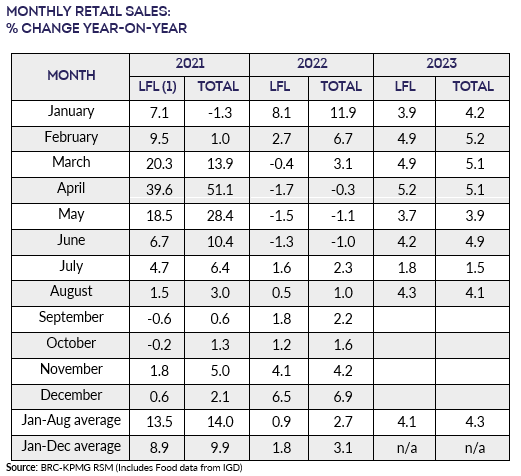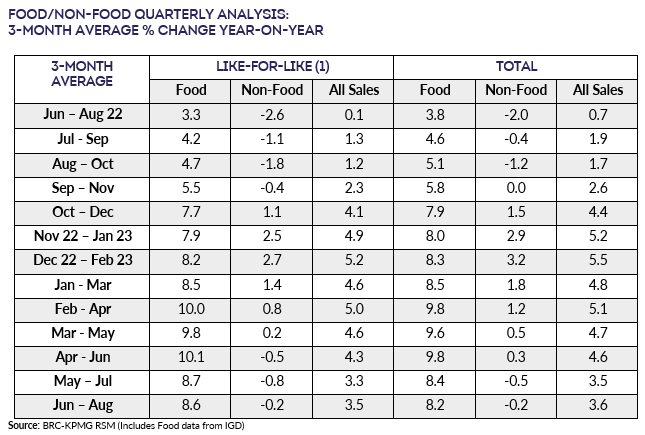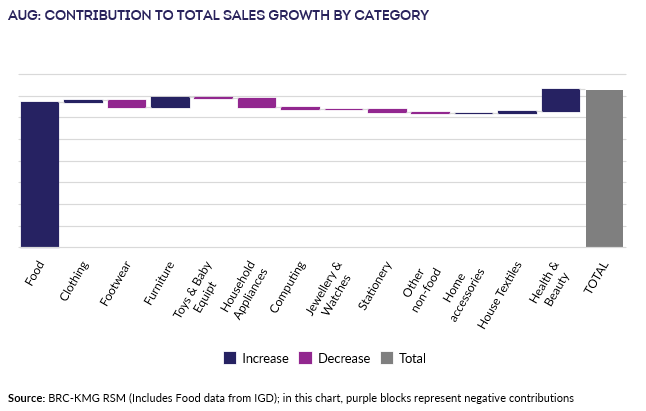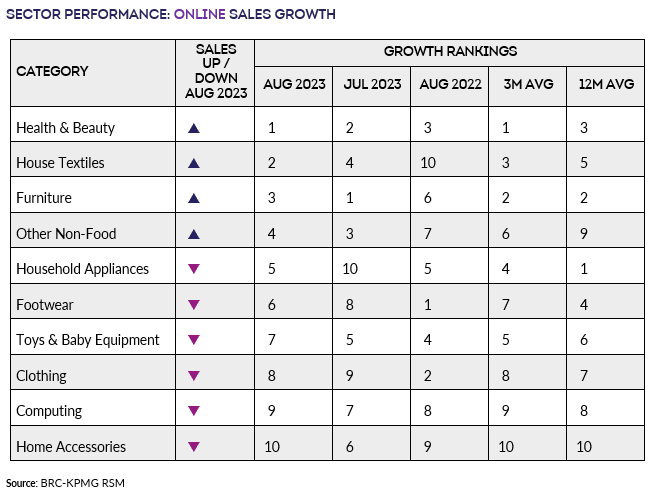Sales figures are not adjusted for inflation. Given that both the
August SPI (BRC) and July CPI (ONS) show inflation running at
higher than normal levels, the rise in sales masked a likely drop
in volumes once inflation is accounted for. Like-for-like data
has been moved from the bullets to the tables at the bottom.
Covering the four weeks 30 July – 26 August
2023
-
UK Total retail sales
increased by 4.1% in August, against a growth of 1.0% in August
2022. This was above the 3-month average growth of 3.6% and in
line with the 12-month average growth of 4.1%.
-
Food sales increased 8.2% on a Total basis
over the three months to August. This is above the 12-month
average growth of 8.0%. For the month of August, Food was in
growth year-on-year.
-
Non-Food sales decreased 0.2% on a Total basis
over the three-months to August. This is below the 12-month
average growth of 0.9%. For the month of August, Non-Food was
in growth year-on-year.
- Over the three months to August, In-store Non-Food
sales increased 1.3% on a Total basis since August 2022.
This is below the 12-month average growth of 3.6%.
-
Online Non-Food sales decreased by 1.7% in
August, against a decline of 6.1% in August 2022. This was
shallower than the 3-month and 12-month declines of 3.1%.
- The proportion of Non-Food items bought online (penetration
rate) decreased to 34.1% in August from 34.7% in August 2022.
Helen Dickinson OBE, Chief Executive of the British
Retail Consortium, said:
“Retail sales in August improved, particularly on July’s poor
performance. Sale of non-food products had their best month since
February, particularly for health and beauty products as
retailers continued to invest in new, exciting brands, and
customers splurged on self-care. The sales figures reflected the
improvement in consumer confidence in August, and retailers hope
this general upwards trend will carry on. Not all areas
benefitted, clothing and footwear saw weaker growth as families
held back spending on children’s uniforms and other
back-to-school goods until the last minute.
“Easing inflation will certainly be welcomed by consumers, but as
the rate of price rises falls, so will the extra spending needed
by consumers. As a result, sales growth may fall in the coming
months, even if volume growth does not. Furthermore, high
interest rates and high winter energy bills will put pressure on
many households to spend cautiously. Retailers are combatting
this through a clear focus on great value for consumers,
expanding budget ranges, and finding ways to cut costs where
possible.”
, UK Head of Retail,
KPMG
“August saw a bounce back in retail sales growth to 4.1%, which
will come as a relief for many retailers.
“Health, beauty and food and drink were the strongest performing
categories both on the high street and online, as consumers made
the most of brief spells of sunshine to enjoy the summer
holidays. Internet retailers continue to struggle as online sales
fell yet again in August, dropping by 3% year on year.
“As summer comes to an end, retailers will have their sights
firmly set on the most crucial period of trading as consumers get
ready for Christmas. Inflation levels are heading in the right
direction, albeit much more slowly than hoped, and savvy shoppers
will be Christmas bargain hunting much earlier this year, as
price continues to drive decisions and consumers seek out good
deals to stretch their budgets. With shoppers becoming more
calculated and aware of what they are getting for their money
than we have seen for a long time, retailers will have to fight
harder for every sale.
“Having survived the pandemic and continuing to battle through
the cost-of-living crisis, we are already starting to see the
resilience of the sector begin to fade and high street casualties
are starting to emerge. Maintaining consumer confidence as we
head into the golden quarter will be absolutely vital for some in
the sector, who will need a good Christmas in order to continue
trading in 2024.”
Food & Drink sector performance | Sarah Bradbury,
CEO, IGD
“Despite the disappointing summer weather, August saw food and
drink sales recovering some momentum that was lost in July. The
progress of the Lionesses in the World Cup brought cheer to
consumers and an excuse for get-togethers around game
times. However, inflation remains the dominant driver of
headline growth in the sector and, although lower now than the
peaks seen a few months ago, it remains high by historical
standards.
“Shopper sentiment was more muted in August, matching the
disappointing summer weather. IGD’s Shopper confidence Index
declined marginally, following recent gains. Shoppers remain
concerned about the relatively high food inflation. Fewer now
believe food prices will get cheaper in the next year (8% vs 11%
last month). Only 13% expect food prices to return to their 2021
level.”







